Three decades ago, touring the Province of Quebec was a completely different experience compared to today. Bruce Jobson reports from Quebec.
Communication in the 1980s and early 90s was very different; in fact almost non-existent. There were no mobile phones, no phone-cameras, no e-mail, no texting, no Twitter, no internet, no Facebook and therefore, no Bullvine website. English was rarely spoken. Today, the modern and cultural face of Quebec has dramatically changed.
For all intents and purposes the Province remains a “country” within a country; it has its own customs and culture and its own dialect of the French language – distinct from the European versions. However, travelling the back-roads, farm-tracks and visiting Quebec milking-barns has changed unrecognisably – as has traditional milking times due to robotic machines, with Quebec now having a 4% uptake compared to 89% tie-stall and 7% free-stall.
Quebec is the power-house of Canadian genetics; a driving force that has gathered juggernaut momentum. This did not happen overnight; and did not happen by chance. This has occurred through ambition, drive, focus, “will-power” and the two “Cs” – communication and cooperation.
Supreme Dairy Show
For the past 20 years, in the week preceding the Royal Winter Fair in Toronto, Holstein Quebec organized a major provincial show at St Hyacinthe. The event garnered prestige owing to the sheer quality of Holstein cows turning out at the event and then moving up to Toronto to take further honours. Today, Quebec can arguably claim to have the best cows.
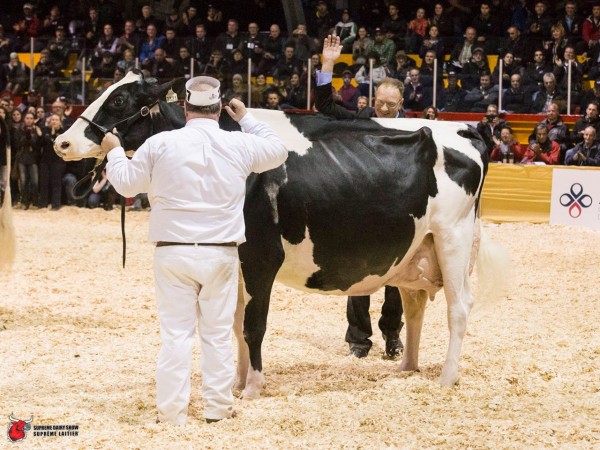
RF Goldwyn Hailey – 2014 Grand Champion Le Supreme Laitier
In 2014, the show format changed through cooperation and a realisation that the Province of Quebec, may, just may, produce a significant third dimension on the North American show circuit juxtapose Madison and Toronto. In simplistic form, an agreement with the city authorities; the 175 year old local Society of Agriculture and the major breed societies, resulted in the expansion from 200 Holstein animals to 750 exhibits across five dairy breeds.
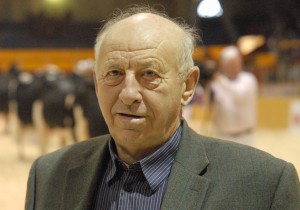
Supreme Dairy Show President Norman Fontaine
President of the Agricultural Society, Mr Norman Fontaine, speaking through interpreter Marie-Claire Girod, explained the reasons for the development. “The Society owns 15 acres of land within the city and wanted to expand the event to be more inclusive and bring other breeds to the show. We also want to attract exhibitors and visitors from other parts of Canada such as Ontario as well as, neighbouring USA and international visitors.
“We have also included a symposium as there is a responsibility to educate the younger generation. There are many aspects to holding a major show such as showcasing animals, trade, an embryo sale and the potential sale of livestock. But educating the next generation plays an important part of our future vision.”
The Role of Quebec Women
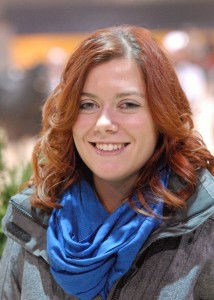
Supreme Dairy Show manager Jenny Henchoz
Quebec has always involved women as part of its drive towards future development; whether in the AI industry, marketing and promotions, showing, milking, breeding or, respective breed societies and organizing committees. Tasked with delivering and managing a multi-breed show, Jenny Henchoz, is typical of the young women who play an important role within Quebec farming circles.
The entire bench of show organisers was staffed by young, professional women administrators in their 20s and 30s (as was previously with Holstein Quebec) taking on responsibility to deliver a major event. Having been at St Hyacinthe events for many years – communication is now easier as the language barrier has virtually disappeared. Commenting on the event Ms Henchoz said.
“We are delighted at the success of the first Supreme Dairy Show with over 750 animals exhibited over the course of the three day event. The show is primarily a livestock event, maintaining a strong link with dairy producers across Black and White and Red and White Holsteins; Jersey, Ayrshire and Brown Swiss animals.
“It’s been a steep learning curve and there has been immense cooperation in order to make the new format happen. The response from breeders, societies, sponsors and trade exhibitors has been tremendous. However, we have room for further expansion with facilities to host over 900 animals, if required.”
Quebec Farm Tour
Charles Darwin stated, “It is not the strongest or the most intelligent who will survive, but those who can best manage change.”
There are approximately 5,000 dairy herds in Quebec compared to 3,000 in Ontario – almost as many in the Province as the rest of Canada combined. In the 2011 census the number of operators involved within Quebec was just under 11,000 – once again; the same number of operators as the rest of Canada.
Quebec also leads with the number of operators below the age of 35, with 1,800 compared to Ontario with 1,000 and the Province has 54% of the Canadian total. Between the ages of 35 – 44; and 45 -55; Quebec again leads the way with 50.5% and 50.8%, respectively. From an age group of 55 and above, the figure dips to 45.2%.
Visiting progeny test herds in Quebec in the 1980s and 90s was a challenging experience. Traditional Quebec family farmers did not speak English and the likes of Steve Laroche from St Hyacinthe-based AI stud CIAQ, acted as driver, tour guide and interpreter when viewing progeny of emerging Canadian Holstein sires.
Today, the younger generation of highly educated farmers, invariably speak English and French. Quebec children now learn English at an early age and TV and films have brought a diverse range of language and understanding into the family living-rooms. This has integrated into the Quebec milking barns.
YOUNG BREEDERS GETTING STARTED
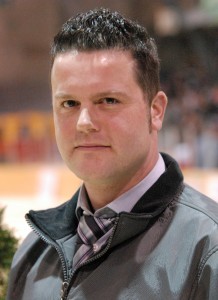
Remi Guay translates French into English at the Supreme Dairy Show, Quebec.
A big challenge remains – getting young people involved in milk production. Remi Guay is typical of the new generation; still in his 30s, he translated the Holstein judge’s native French into English at the inaugural Supreme Dairy Show at St Hyacinthe and the following week at the Royal Winter Fair, translated English comments into French for the Jersey breed. He started milk production in October 2009, having purchased his father’s Hillover Farm on the Quebec-Vermont border.
Purchasing milk quota for 15 animals leverages any fledgling business however; an official Canadian scheme to help new entrants donates an additional quota for five cows to help get new entrants started. Each year, over the next five years, the level is reduced by one cow – and it is hoped, the new entrant is able to replace with additional quota.
During the past year, very little quota has come onto the market by way of auction, and in some cases, the quota auction has been cancelled due to lack of supply. In order to expand his business, Remi may decide to sell his current holding and purchase a larger farm – with additional quota.
He said: “Milk quota purchase has stabilised at $25,000 per cow over the past few years; but none is available at present and a lot of people are also seeking to expand. It’s a ‘catch-22’ situation. However, I consider that if we are to expand or purchase another farm, this is a positive investment for the future.”
Owing to higher level of milk components, less required milk volume and higher milk price (around 90cents litre) it can be advantageous to milk Jersey animals within the Canadian Supply Management (quota) system. Furthermore, the traditional Quebec tie-stall milking barns do not have to be extensively renovated to accommodate Jerseys compared to the modern Holstein cow; and pedigree Jerseys can be purchased at reasonable prices compared to Holsteins.
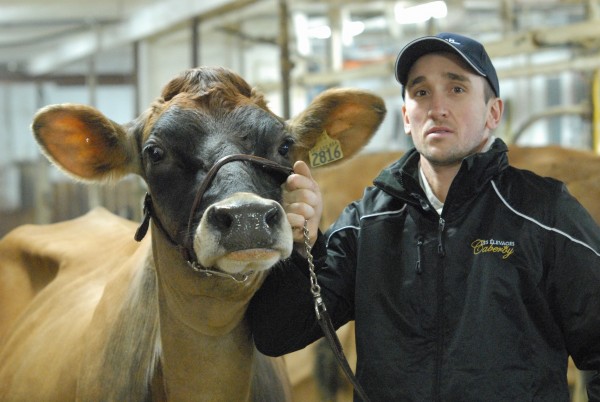
Dave Berube of Caberoy Jerseys with FDL Minister S Blessing VG88 – August 2014 #1 Jersey Conformation Cow.
Preferring to focus on high genomic material, Remi sold four milking heifers including the August 2014 no. 1 Jersey Confirmation cow, FDL Minister S Blessing VG88. She was purchased by Dave Berube, a 32-year old breeder who had started his own Caberoy herd, six months earlier. He was also assisted by the official quota scheme and received an additional allocation.
THE COSTS OF EXPANSION
Dave Berube is similar – a young, ambitious, 35-year old motivated breeder, eager to get on the first steps of the farming ladder. He has a wife and young family and is also seeking to further expand his 30 milking cow herd; originally from a Holstein background, Dave also started with Jersey cows and speaks excellent English.
“The costs remain extremely high to gain a foothold within the Canadian dairy industry and the level of investment required can be off-putting for young people eager to get started. The hours are long, often working on your own, but the dairy industry is rewarding and I love working with my cows. It has always been my ambition to be a herd owner and in time, I aim to expand,” he says.
Thirty years ago, Holsteins were dominant and the Jersey breed static or, in decline. A major change during the past decade has been the emergence of Jersey herds as well as mixed herds of Holsteins and Jersey breeds. The increasing brown-cow popularity is not just confined to Quebec or Canada; with US Jersey figures predicting 20% of the US semen market by 2020.
Besides the benefits of herd health, calving-ease and animal welfare aspects, the younger generation, with limited budgets, can better afford the price of Jersey calves for 4H competitions. The high price of purchasing a Holstein show-calf; unless homebred – may have influence within participating family circles.
The Demise of the Sire Analyst
While Quebec maintains its own major AI organisation, the number of Canadian units has declined. Twenty years ago, neighbouring Ontario had three major AI units under the Semex Canada banner in the shape of WOBI, Eastern Breeders and United Breeders; today; amalgamation and “restructuring” has resulted in one Ontario-based Semex Alliance company, EastGen.
Before genomic testing, it was common to cross paths with numerous Canadian sire analysts treading the same Quebec back roads, viewing progeny or making bull contracts on cows. Comestar Holsteins, Victoriaville, was always a popular location as the Laurie Sheik family evolved into a dominant Canadian bloodline. Each AI unit was fiercely independent and with huge loyalty from its membership, procured its own bulls.
Independent AI unit competition was therefore more intense – but today; that is no longer the case under the unified Semex Alliance banner. Today; generation turnover is intense. And a sire analyst “eye-balling” a second or third lactation animal, bred from three generations of VG or Excellent cows appears an antiquated concept – and bullmothers and genomic young sires are predominantly identified at birth through genomic screening. The role of the traditional sire analyst has changed – and young bulls do not need to have any milking daughters to have an evaluation.
QUEBEC AI INDUSTRY REVAMP
For the past 25 years, the logo acronym, CIAQ (Centre d’insemination du Quebec) has become one of the most powerful symbols within the cattle-breeding world. Pronounced in Quebec as “see-ak” -the organisation has developed many of the greatest bulls to have emerged through the Canadian evaluation system including the legendary Hanoverhill Starbuck.
In November 2014, the organisation updated its logo and tag-line to reflect the modern identity of the company. The acronym now becomes a word in itself written as, Ciaq and a new logo promotes the company with the sun rising over the landscape horizon. A new corporate tagline promotes the company vision and its core values with “Let’s conceive the future.”
The organisation is located in St Hyacinthe, which is effectively the agricultural-hub for businesses, education and cattle-breeding within the Province. Established in 1948, Ciaq employs 320 people across all divisions and operates over 200 qualified field technicians throughout Quebec.
Cooperation remains at the very heart of the organisation, which is owned by three groups; Quebec milk producers (PLQ) Quebec breed associations (CQRL) and Quebec breeding clubs (CPCAB) Today, Ciaq is the driving force within the Canadian AI industry accounting for 45% of the domestic market-share and supplies over 800,000 units of semen annually to Quebec breeders. Ciaq also owns 45% of Semex Alliance, with the remaining 55% in partnership with Eastgen and Westgen AI centres.
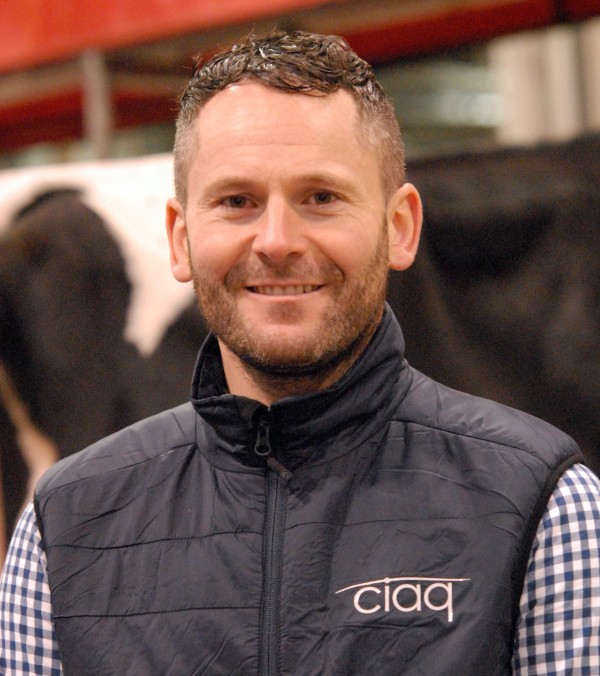
CIAQ communications director Vincent Landry wearing the new corporate logo.
The launch of the new corporate identity took place as part of activities during the inaugural Supreme Dairy Show at St Hyacinthe. Attendees were also invited to visit the new CIAQ facilities at nearby Sainte-Madeleine, view some of the top sires; tour the sexed semen laboratory, semen collection facility and distribution facility. Commenting on the new company profile, CIAQ communications director Vincent Landry said:
“The previous logo of a bull’s head was introduced in 1988 and we wanted to update the image to reflect a modern and forward thinking organisation that has farming at its core-value. The consultation process has taken over a year and CIAQ conducted a large survey with its dairy and beef producers as part of the process.”
Quebec Today
The Province of Quebec remains an enigma, at times complex due to its quintessential French customs juxtapose its deep, rich cultural heritage. The ability to communicate in spoken and written English and the use of modern communication technology; has aided and brought mutual understanding; greater cooperation, integration, opportunity, focus and development of desired business goals. Quebec has, as Darwin stated: “managed change.”
Get original “Bullvine” content sent straight to your email inbox for free.

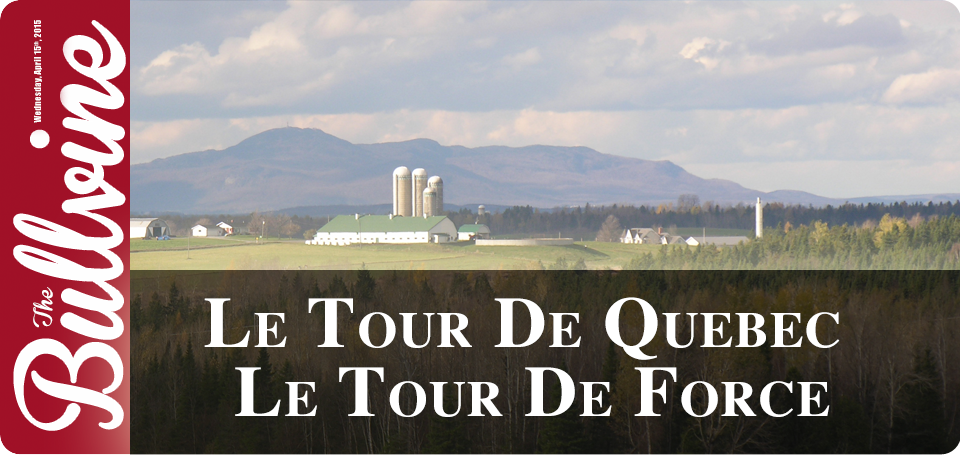












Leave a Reply
You must be logged in to post a comment.